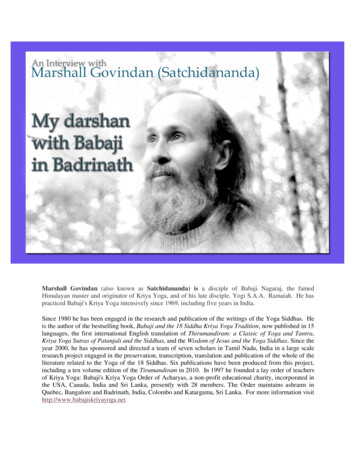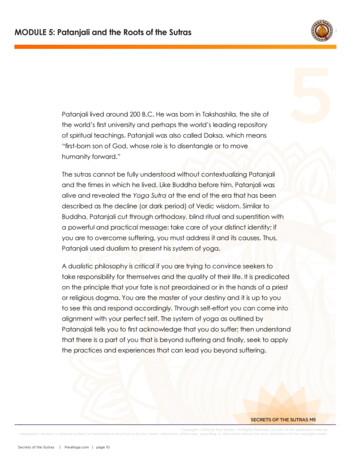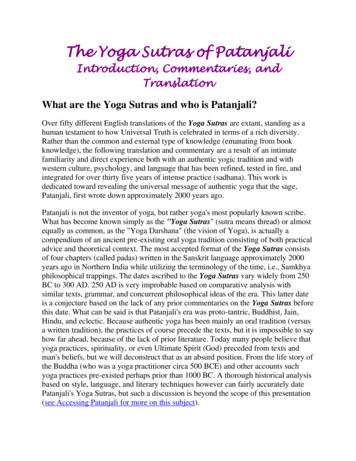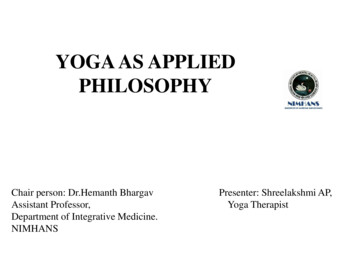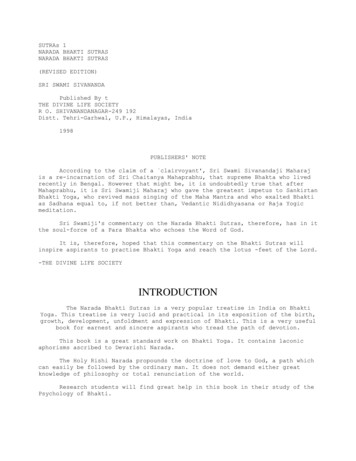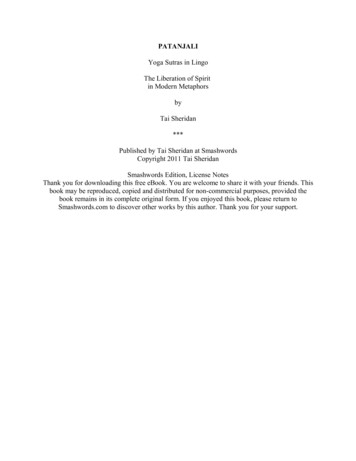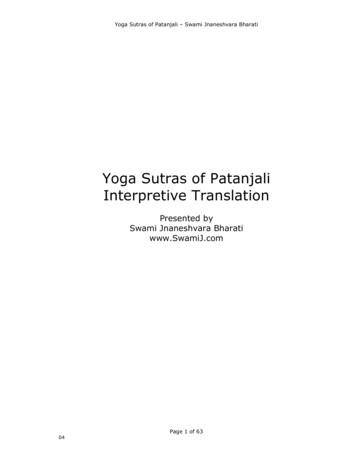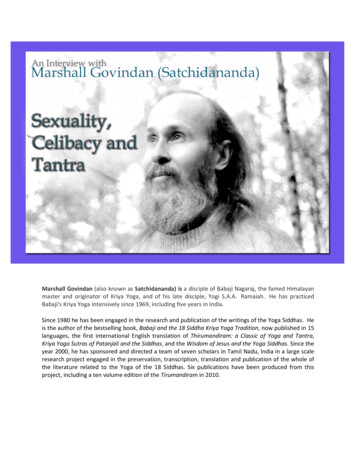
Transcription
Marshall Govindan (also known as Satchidananda) is a disciple of Babaji Nagaraj, the famed Himalayanmaster and originator of Kriya Yoga, and of his late disciple, Yogi S.A.A. Ramaiah. He has practicedBabaji's Kriya Yoga intensively since 1969, including five years in India.Since 1980 he has been engaged in the research and publication of the writings of the Yoga Siddhas. Heis the author of the bestselling book, Babaji and the 18 Siddha Kriya Yoga Tradition, now published in 15languages, the first international English translation of Thirumandiram: a Classic of Yoga and Tantra,Kriya Yoga Sutras of Patanjali and the Siddhas, and the Wisdom of Jesus and the Yoga Siddhas. Since theyear 2000, he has sponsored and directed a team of seven scholars in Tamil Nadu, India in a large scaleresearch project engaged in the preservation, transcription, translation and publication of the whole ofthe literature related to the Yoga of the 18 Siddhas. Six publications have been produced from thisproject, including a ten volume edition of the Tirumandiram in 2010.
Sexuality, Celibacy and TantraBy M. Govindan SatchidanandaCopyright 2014ContentsQuestion: Why have you decided to give this interview? .3Question: What is celibacy, and what is its purpose? .4Question: What must one do to prepare oneself to adopt celibacy? It appears that evenhighly motivated spiritual seekers would consider it to be a very challenging austerity intoday’s material culture. .5Question: What consideration should be given to one’s cultural and social environmentbefore adopting a vow of celibacy? .7Question: I understand that you belong to a Siddha tradition, whose teachings are tantric.How do you reconcile the practice of celibacy with those of Tantra? .8Question: You indicated earlier that there was a great danger of suppression in attempting tocontrol ones sexuality through a vow of celibacy. .9
Question: Why have you decided to give this interview?I was asked by the online magazine “Nonduality magazine” to submit an article on the subjectof celibacy. After considering it and jotting down a few ideas I decided to submit the article.This interview reflects that article.With regards to the subject of “celibacy” there is a lot of misunderstanding, especially sincevery few persons have ever practiced it. As I adhered to a vow of celibacy for 18 years, I believethat I can help to clear up some this misunderstanding, and share some practical means tothose readers who would like to avail themselves of its benefits.Anything, including celibacy, which touches upon human sexuality will almost always becontroversial. This is because it is related to human values, and unless one is living in someremote part of the world where there is only one set of values, a mono-culture, people will lookupon sexuality differently.Even within those who should have the understanding if not the wisdom to appreciate therelationship between sexuality and spirituality, human sexuality is problematic. Therefore,whenever one considers anything related to this sexuality, one needs to view it with referenceto the philosophical if not religious teachings which provide direction to whatever practices ordisciplines or moral choices one adopts. If these are unclear, or undecided, it may be best tofirst reflect on these, come to some conclusions and make some decisions, before consideringwhat to practice, and how to answer questions related to sexuality.Even if one has made nondual awareness, Self-realization, God-realization, enlightenment,liberation or nirvana one’s ultimate spiritual objective, state or value, sexuality will very oftencause detours, in which one forgets, even for many years, what one is seeking. I am remindedof the famous lament of St. Augustine of Hippo, one of the founders of Christianity, who lived inNorth Africa during the fourth century. Before he became a Christian celibate monk, hebelonged to a sect known as hedonism, and had experienced his fill of human sexual adventure.Hedonism is a school of thought that argues that pleasure is the only intrinsic value. In verysimple terms, a hedonist strives to maximize net pleasure (pleasure minus pain). As a youngman he uttered his famous prayer, "Lord, grant me chastity and continence, but not yet.” Whowas it that at the beginning of this brief prayer who asked the Lord to help him to be celibate?And who was it that by the end of the same prayer had forgotten? Now, in the 21st century,Western culture, especially in America, is a curious mixture of hedonism and religiousrestriction. While most religions require restrictions on sexual activity, as we shall see below inthe discussion of Tantra, human sexuality and spirituality are not mutually exclusive. Confusion
and conflict occur however, when one’s objective is not singular or firmly held, and oneunderestimates the power of sexuality to distract, as in the case of young St. Augustine.Question: What is celibacy, and what is its purpose?Marshall Govindan: Celibacy is purposeful abstention from sexual activity which begins with aformal vow. It is not merely living one’s life without sexual relations. As such, celibacy is asdifferent from merely not having an active sex life, as fasting is different from merely not havinganything to eat!In the West, the only persons who are generally qualified to say anything about “celibacy” arethose who have taken vows, for example, current and former Catholic priests, monks and nuns.Others can only express questions, because without experiencing it, opinions can express onlyhere say.Taking a vow of celibacy will strike nearly every adult as strange, unnatural or foreign,particularly in the modern Western popular culture, where the average person is continuouslybombarded by advertising and the media to entertain sexual fantasies, virility or associationwith sexual attraction. Happiness requires an active sex life according to advertisements forViagra, and millions of men believe it.In India, celibacy is usually referred to as “brahmacharya.”The word “brahmacharya” means“knower of Brahma,” that is, one who is able to access the nondual transcendental state ofawareness. It is one of the yamas, or social restraints of Patanjali’s “eight limbed” (ie. astanga)yoga, and in that context implies the broader concept of chastity, in thought, word and deed.As a “social restraint” or yama, it is prescribed as a means of spiritual Self-realization, toprotect the seeker in social relationships, where the ego’s manifestations, which include pride,greed, lust, and anger, can cause mental delusion and inter-personal conflict. The other yamasinclude not harming, not lying, not stealing and greedlessness.Celibacy, therefore, is not merely abstaining from sexual activity. It includes avoiding lust,sexual desire and fantasy.Celibacy’s greatest purpose is to slay desire, the principle of all our superficial life, whichsatisfies itself with the life of the senses and in the play of the passions. When we eliminatedesire, that propensity of our natural being, the passions, the emotional results, will fall intoquietude. A calm equality will then be gained. As a result, the delusion that “I am the body,”and “I am my feelings, emotions, wants, and thoughts,” is gradually replaced by the realizationthat “I am,” that which never changes, that Witnesses the drama of my life, as “being,consciousness, and bliss,” sat chid ananda.
Celibacy is not an end in itself, but a means to realizing a greater spiritual or religious purpose.In Christian religious orders a vow to maintain celibacy is part of one’s complete dedication toChrist and the work of His Church. Catholic nuns or sisters are taught to view themselves as the“brides of Christ.” When viewed as a means to a greater purpose, it makes perfect sense. It isnot unlike a marriage vow of faithfulness to one’s wife or husband which helps to ensure thesuccess of the marriage. In Hindu and Buddhist monastic traditions, in order to keep one onthe path to moksha or spiritual liberation from the wheel of samsara, endless desire andreincarnation, it is part of a three-fold life time vow of celibacy, poverty, and obedience to one’sspiritual preceptor or to the discipline of one’s monastic order.Question: What must one do to prepare oneself to adopt celibacy? It appears that evenhighly motivated spiritual seekers would consider it to be a very challenging austerity intoday’s material culture.Marshall Govindan: Celibacy is a form of austerity, or tapas. Tapas means self-challenge,voluntarily assumed, for the purpose of effecting a positive change in one’s life.Tapas has three essential elements:1. A vow, which expresses one’s intention or sankalpa. To be effective it should include aclear, positive statement in the present tense, using a verb which leaves no doubt evenat the subconscious level as to one’s intention. For example: “In thought, word andaction, I remain chaste.” Or “I see in others only the embodiment of the Divine.”Statements like “I hope to” or “I want to” which imply doubt are avoided. One’s vowshould not include reference to what one is trying to avoid, otherwise, it may contributeto psychological suppression. One therefore concentrates on what one is seeking:Brahma, the universal nondual state of consciousness. A vow of tapas is generally madefor a predetermined period: for example, a day, or a month, a year. So it is usuallytemporary, but it may be for the remainder of one’s life.2. The exercise of ones willpower. When desires come, one does not dwell on them. Onedoes not allow the mind to fantasize nor to dwell on memories of sexual experiences.Above all, one’s mantra is “I shall not manifest it (this desire) with any word or action,”for example through masturbation or flirtation. A little success will multiply one’swillpower. Failure will weaken one’s willpower by a multiple degree.3. Persistence: sincerity is doing what you say you are going to do. So, no matter howdifficult, no matter the failures, no matter the doubts of one’s capacity, one continuesto exercises one’s discernment and one’s willpower. One notices when desires begin to
enter the mind, and one exercises detachment towards them immediately. Onedetaches from the mind’s attempts to justify the desire.Tapas is most often applied to vows of silence, vows of fasting, dietary vows, vows ofrenunciation of material possessions, family, vows of obedience to a guru, vows related tosocial behaviour, vows to strictly follow the disciplines prescribed by a guru, and extremelyascetic practices such as sitting in meditation surrounded by small fires, for many hours overmany days.One can apply the principles of tapas to anything you want to change in your life. For example,eliminating a bad habit, like anger, over eating, swearing, smoking, gossiping, or to developingnew positive habits, such as rising early, being kind or generous, physical exercise, regularity inmeditation or other spiritual practices, self-control, developing virtues of honesty, patience,humility or frugality.Tapas or austerities can be done for purpose of developing power, when one’s intentions aremoved by the force of rajas, expressing itself in the need to be active, to create, to exert oneself. Tapas can done for the purpose of penance, out of guilt or atonement for past errors, or asa sacrifice with the expectation of absolution, or forgiveness. This reflects the guna of tamas,or inertia, doubt and fear. But for the authentic spiritual aspirant, only tapas which reflects thesattva guna of balance, calmness, clarity, understanding, peace, and various virtues including aspatience and love are acceptable.The decision to take a vow of celibacy must be in alignment with one’s purpose. If someonedecides that their life’s purpose is “Self-realization” then vows of celibacy, silence andobedience, can be very helpful. The vows made to fulfil this purpose express an aspiration to befree of egoism, attachment, aversion, and to realize absolute Being, Consciousness and Bliss.When made with this purpose, such actions are not contrary to human nature, nor are theymerely moral, but done in alignment with swabhava, the essential law of one’s spiritual nature.They express the purposeful will of the Divine in us searching for and discovering not thepleasure of the lower Nature, but the Ananda, unconditional joy, of its own play and selffulfilling. Dharma is usually understood as righteous action, ethical or moral conduct. But in thespiritual sense dharma is not morality or ethics, but action governed by swabhava, the law ofself-becoming and divine being in the Soul. Humans are not compelled to limit their identity tothe current limitations in their personal nature. The soul has no such limitation. It is moved by alaw of becoming. Spiritual disciplines enable one to fulfil the law of the soul, its swabhava.Austerities are relative, and depend upon the person and their experience. For example, whenone decides to give up eating meat, and become a vegetarian, it feels difficult at times, it feelsaustere, because one misses eating meat, and one’s family and friends express their
disagreement with doing so. But after being a vegetarian for a number of years, one no longermisses meat; and when one no longer misses eating meat, it ceases to be an austerity. It issimply what one does. One no longer identifies with it.Therefore, while celibacy may feel difficult initially and for some extended period, as long asone continues to entertain lustful thoughts or sexual fantasy, once one develops the skill to “letgo” of these, celibacy becomes easy. One simply is. One is no longer the person who is notgetting any sex.The great danger of this form of tapas is that in one’s effort to control one’s sexuality, one mayonly suppress it. Instead of “letting go” of sexual fantasy and desire, one may add to itssamskara or habit by dwelling on it.Question: What consideration should be given to one’s cultural and social environmentbefore adopting a vow of celibacy?Marshall Govindan: The decision to make a vow of celibacy needs to be made after consideringwhether one’s environment is going to be sufficiently supportive. Do you need to and if so, canyou give up watching movies which involve sexuality? Are you going to school and surroundedby persons who tempt you? If you are working in a place which brings you into contact withmany sources of temptation, it may be necessary for you to decide whether you can manage it,or change where you live or work. It will be easier to maintain the vow if you are living in aplace which is isolated, for example a rural retreat center. Or even if you commit your free timeto your practices and study rather than to socializing.In India, in certain orthodox Hindu communities, children take a vow of brahmacharya at theage of puberty, so that until they are married, all of their energy can be directed towards theirstudies, both spiritual and temporal, and so prepare themselves for the second phase of life,the heavy responsibilities of family life. The life of the student is the first stage of four stages, orashramas of life. It is followed by the life of the householder, the grahasta, wherein one enjoyssexuality activity, creates and maintains a family, contributes to society’s economic needs.When one’s children are grown and have become married, then the third stage of life, that of aretired person, a vanaprasti, when one has more time for self-study, contemplation of eternalverities, public service and spiritual seeking. Typically during this third phase, sexual activitiesare avoided. This third stage prepares one for the final ashrama, the fourth stage of life, knownas sannyas, wherein one may choose to renounces one’s material possessions and family. Thischoice may be formalized with vows of renunciation, made with or without the blessings andguidance of a spiritual preceptor. Such vows will usually include vows of celibacy. In India,most sannyasins, are men, and they can be identified by their ochre colored clothes. But manywomen enjoy a special status when they reach the age of sixty, which allows them to be freed
of family responsibilities and to dedicate their time to activities associated with religion andspirituality. Such women choose to mark this status by wearing only white.A social code will also be supportive. In India, men socialize only with men. Women socializeonly with women. Even in social gatherings, this has been the rule, until recently, whenWestern social behavior, through modern media, has weakened the observance of this socialcode. Otherwise, dating is frowned upon. Group social activities are the norm. Such limitationsserve to prevent unwanted advances and unnecessary intimate exchanges. Unfortunately italso leads to frequent psychological suppression, because people are ignorant of the need for“letting go” of sexual fantasy, and even less skilled in practicing it. Fueled by the influx ofpornography and Western values, India’s spiritual and religious culture is threatened. If onedecides to follow such a social code, one must also avoid mentally “pushing away” with others,as this may create psychological suppression, and worse, misogyny, or antipathy, and towardsothers, and alienation. One must also avoid the belief that one is superior to others. Such abelief is sometimes fostered within religious sects.Question: I understand that you belong to a Siddha tradition, whose teachings are tantric.How do you reconcile the practice of celibacy with those of Tantra?Marshall Govindan: While celibacy is usually associated with spiritual traditions which renounceinvolvement in worldly life, both in the East and West, it plays an important role in preparingadepts in various sects of Tantra. “Tantra” has many meanings. It means “web” and in thissense refers to the web of teachings which unite the spiritual and material worlds. Tantra alsorefers to “teachings” which encompass the use of energetic practices, to bring about atransformation of human nature. It is based upon the Samkhya, the dualistic philosophicschool which posits two fundamental poles of reality, the Seer and the Seen,spirit/consciousness and nature. The writers of the tantras, whether they are Hindu orBuddhist, recorded the results of their experiments with the subtle anatomy, including thechakras and nadis, using pranayama, mantras, visualization, inner worship, and finally hathayoga. Tantra includes practices which involve sublimating sexual energy, bindu, into spiritualenergy, ojas, through kundalini yoga. Practitioners of tantra are known as sadhaks, those whofollow a prescribed sadhana, or discipline. Adepts of tantra are known as siddhas, or perfectmasters of human nature. The tantrics realized that human nature can be transformed, basedupon the principle of identifying with Shiva-Shakti, Conscious-Energy. They realized thatconsciousness follows energy and that energy follows consciousness. Everything emanates fromSupreme Consciousness, referred to as Shiva and Supreme Energy, referred to as Shakti.Much of tantric yoga is ulta-sadhana, or “contrary practice.” Unlike traditions which avoidcontact with worldly activities, considering them to be illusionary or distracting temptations,the tantrics embraced the world of nature and sought to transform their human nature. They
considered the Divine to be both transcendent and imminent within everything. Performingtapas in most cases involves doing the opposite of what human nature requires. For example,keeping silence rather than speaking, fasting instead of eating, remaining awake when the eyesare closed, and maithuna yoga, sublimating semen and sexual energy upwards rather thanejaculating during sexual intercourse. This leads to control and silencing of the mind, therealization of Oneness, when this energy reaches the crown of the head. Consequently, desireis removed and one may realize enlightenment and immortality. The foremost text of Tantra inthe Yoga Siddha tradition of south India is the Tirumandiram, written by the Siddha Tirumular inthe Tamil language, probably between the 4th and 5th centuries A.D. It includes an entirechapter (section 19 of tantra 3) on sexual yoga with a partner, maithuna yoga which he refersto as “paryanga yoga”.Until and unless one is established in the witness consciousness, for which the discipline ofbrahmacharya or celibacy, is so valuable, one will generally not be successful in the practice ofpariyanga or vajroli yoga or maithuna yoga. Unfortunately, today in the West, so calledpractitioners of “neo-tantra” promote “sacred sexuality” as a means of having longer anddeeper orgasms. This only serves to strengthen the delusion that “I am my body” and thatone’s happiness depends upon pleasuring it, and avoiding what is uncomfortable. Authentictantra teaches that unless one maintains the perspective of the Witness, the Seer, makingeverything else, every sensation, every thought, every emotion, the object of one’s awareness,the Seen, it is not authentic tantra. Therefore one must first purify the vital body of desire to alarge extent before one can even attempt to practice paryanga yoga or maithuna with apartner. The application of breathing and relaxation techniques, muscular locks andvisualization can then be used successfully to sublimate sexual energy during intercourse. Onerealizes Oneness with the Supreme Being. One becomes Shiva-Shakti in blissful union.In the teachings of authentic tantra celibacy realizes its full potential as mean of purifying thevital body of desire. The Siddhas, or adepts of Tantra were not life long celibates. Theyperformed tapas as celibates for extended periods to develop mastery over their human natureand to purify themselves of desire. They practiced kundalini yoga to sublimate sexual energy.They also practiced paryanga yoga to transform bindu into ojas and enter into Oneness. Butparyanga yoga, like celibacy, is a means to ultimate God realization, here in the world,embracing and transforming nature. It is not a complete path, according to Tirumular, but itmay be part of one.Question: You indicated earlier that there was a great danger of suppression in attempting tocontrol ones sexuality through a vow of celibacy.Marshall Govindan: Celibacy requires great skill and self-awareness. Otherwise it results inpsychological suppression of desire, and consequent neuroses. One slays desires not by
suppressing them, but by observing them, and “letting them go.” Not only celibacy, but anyobject of desire, any intention which one sets for oneself, for example, dietary restriction, ormarriage fidelity, can become a source of inner conflict. That is why more than half of the adultpopulation in the West suffer from serious neuroses. Anyone who begins to meditate, or withthe help of a therapist, begins to observe their thoughts and emotions with detachment caneventually develop the skill required to “let go” of them. As most emotions entail suffering, thepractice of meditation can weaken these sources of suffering, the samskaras, or habits of mind.But only by repeatedly returning to the nondual state of consciousness, samadhi, can oneuproot these habits, according to Classical Yoga, as expressed in the Yoga-Sutras of Patanjali.“Letting go” of desires requires that one observe them as they arise. One uses one’s intellectualfaculty of discernment to recognize the desire for what it is: a disturbance of the vital body.One may label what kind of desire it is. By doing so, it ceases to be “me” or “mine,” orsubjective; it becomes an object, like a cloud, or a tree. One does nothing to manifest thedesire until or unless one is in a calm state, with little or no preference as to whether to indulgeit or not.It is not the object of desire which is to be avoided usually. It is not the object of desire which isusually problematic. The bar of chocolate just is. The attractive co-worker or acquaintance justis. It is the desire which is problematic. It is desire that must be slain. Desire creates suffering.This is one of fundamental tenets of all spiritual traditions around the world, and all Easternreligions. One’s spiritual progress is inversely related to the degree to which one is subject todesire. If one does not yet recognize this, then reflect deeply upon it, and examine the wisdomteachings of authentic spiritual traditions.Convinced of its value and with the courage to apply yourself to it, consider making a vow ofcelibacy for some period, for example, two weeks, a month, three months, to begin with. If youare in a relationship be prepared to explain why to your partner and invite them to do so also.If you fear that you will lack the capacity to fulfill the vow, then work on the subject of fear forawhile, with meditation and self-study. You will be amazed by what you learn about yourself,and what you are not.References:Tirumandiram, tantra 3, section 19, on paryanga yoga. Available tore.htm#nine tandirams book’
Kriya Yoga Sutras of Patanjali and the Siddhas, translation and commentary by MarshallGovindan, available from Amazon.com and ore.htm#patanjali bookBhagavad Gita: Verse VI.13-14: which prescribes celibacyHow I became a disciple of Babaji, by Marshall Govindan, 2000, Babaji’s Kriya Yoga andPublications, available from Amazon.com and ore.htm#disciple book
Since 1980 he has been engaged in the research and publication of the writings of the Yoga Siddhas. He is the author of the bestselling book, Babaji and the 18 Siddha Kriya Yoga Tradition, now published in 15 languages, the first international English translation of Thirumandiram: a Clas
